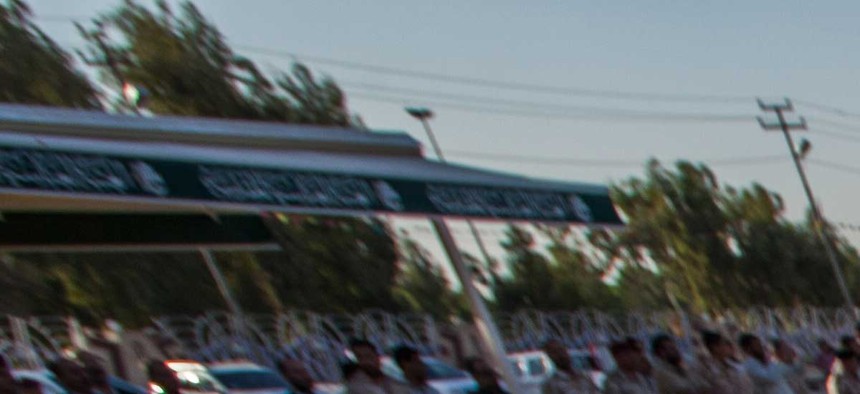
Volunteers in the newly formed Abbas Brigades parade near the Imam Hussein shrine in Karbala, Iraq, on August 14, 2014. Ahmed al-Husseini/AP
Obama’s Speech Reflects a Refined Foreign Policy Doctrine
The president’s speech presents a refined American engagement that relies not just on our kinetic capabilities. By Maj. Mike Lyons
The president painted in bright lines in his speech to the American people on Wednesday night, presenting a clearly defined strategy for dealing with the Islamic State: degrade and destroy with air power, allies and broader reform.
There is, however, another major significance of this strategy in that it differs greatly from how the previous administration administered military assets in the region. Obama, true to his foreign policy principles, explained that America is going to lead a broad coalition to roll back this terrorist threat without sending large deployments of combat troops to the region to get mired in what will likely be a protracted regional ground war in both Iraq and Syria.
Some pundits immediately took to social media to wail about the speech falling short of a “strategy,” though no one should be surprised that the commander-in-chief chose not to explain battle plans in prime time. The Joint Chiefs, however, did get the president’s intent from his speech, and from that intent, they will be able to put together the military portion of the plan to combat the Islamic State. That plan is composed of several fundamental pieces.
First, the U.S. will have to put together a coordinated air campaign that both attacks targets of opportunity on the battlefield and provides humanitarian assistance to civilians. This core objective fits perfectly into the Obama Doctrine of using military force to aid allies on the ground and leading the way in multilateral efforts to provide relief to those in dire straits. Indeed, this is the strategy that has already been employed to great effect in Iraq, saving members of the Yazidi ethnic group and providing cover to Kurdish forces retaking key strategic assets over one hundred air strikes ago.

Second, training of the Iraqi security forces must be accelerated to make them both combat effective and capable of fighting with U.S. air cover. This is now possible, as the president explained, due to the newly formed Iraqi government that genuinely aspires to an inclusive, unified and representative character. A dramatically more ambitious challenge in building partner capacity comes in the form of the training of allies on the ground in Syria. The intelligence community has hard questions to ask and answer regarding whether there is enough time to accomplish such a venture, where training would be possible, and the number and competency of soldiers that exist on the ground at present.
The other difference in this strategy over those of previous years is the true application of the operational art of war. Aside from the application of military power, the president is harnessing both diplomacy and financial pressure to isolate and weaken the Islamic State. This counterterror campaign will be won with the close cooperation of our joint services and multinational allies. Tactical victories on the field, celebrated though they may be, do not guarantee success at the operational or strategic level. If there is one lesson we have learned from Iraq and Afghanistan, surely it must be that this effort will not be won by any single battle. It is going to take a campaign of air, ground and sea military assets, a coalition of countries who even might even be on the fence or adversarial at times, and the determination to see it all through.
Unlike “shock and awe,” the strategy to defeat the Saddam Hussein’s Army the first time, this will be more like “blunt and attrition.” The president recognizes we first must blunt the advances of IS in Iraq while the Iraqi government gets organized. U.S. airstrikes have been a critical first step, protecting critical infrastructure inside Iraq, assisting the ground forces and providing cover for Americans in Iraq. Now it’s time to go on the attack; pushing back against narratives that constantly accuse him of weakness or indecisiveness, the president’s speech cited recent successes in Somalia and Yemen as evidence that his administration is ready and able to tackle this newest terrorist threat.
The strategic reality on the ground makes “blunt and attrition” the smart way forward. In this situation, America’s unmatched air power will continue to have a tremendous impact on pushing IS back into Syria. Their forces are currently positioned largely along the road networks connecting the towns they occupy. Resupply convoys moving throughout this slipshod network will be easy targets for the 24/7 drone surveillance that has become standard operating procedure. If IS continues to fight conventionally, they will be ground down to the point to becoming combat ineffective.
All this is not to say the president’s strategy does not come without risk. There will be challenges out of the gate. The president was absolutely right to reinforce that we cannot rely on the Assad regime in Syria, and that an implied coalition of the willing will also pursue the political solution necessary to solve both the Iraqi and Syrian crises of governance once and for all. In short, the end results of destroying the Islamic State and stabilizing regional governments are years in the future, and anyone with claiming they have a “strategy” that says otherwise is a fool or a liar.
The stage is set for American leadership, and the president’s speech presents a refined American engagement that relies not just on our kinetic capabilities. With the support of Congress and a rising tide of American public opinion in favor of action, it is time to begin in earnest the challenging task of eliminating a threat to the United States. Obama’s bright line strategy is now clear, and with American leadership, will lead to the eradication of is the Islamic State and their corrosive effect on the greater Middle East.
Army Maj. Mike Lyons (Ret.) is a West Point graduate, CBS Radio News military analyst and a senior fellow at the Truman National Security Project.
Follow him on Twitter @majmikelyons





